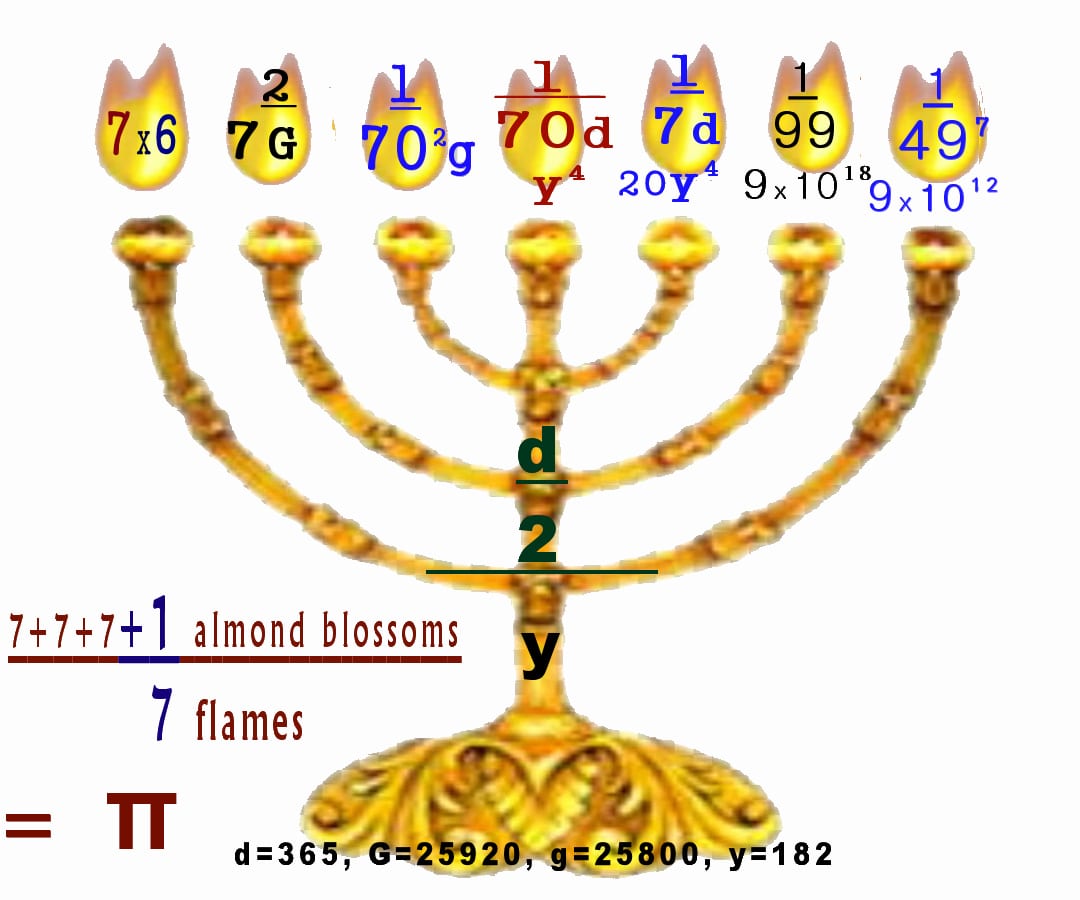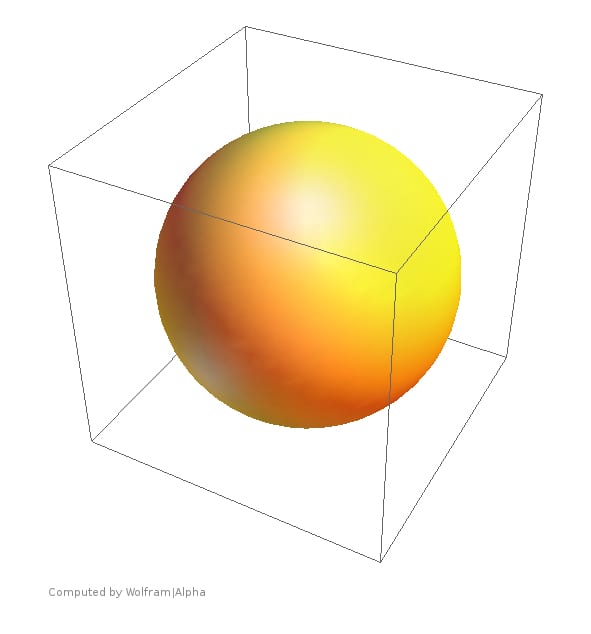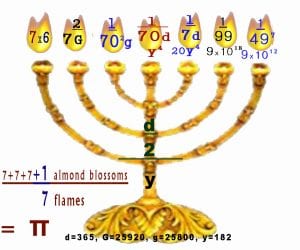- This is Part One
- Part Two
- Part Three
- Part Four
Today, Oct 6th, is the anniversary in the Jewish calendar of when God rested on the 7th day after His six days of Creation.
Today begins a series of simplified articles to describe how Pi (the ratio of the diameter to the circle) articulates redemption.
Pi underpins the vast numeric of the Bible and history itself. Pi is how God, through Christ, redeemed man in all its immense intricacy. It’s the behind-the-scenes structure and framework of the Bible and the natural world.
Ten thousand books are insufficient to unravel this mystery. Hence, as simply as possible, just key points will now be explained. The rest will unfold like the Flower of Life.
First two branches of the Menorah of Pi
Below is the non-algebraic form of precisely the same equation.
The above formula represents just the first two branches of the full formula.
The first two branches are all that is needed for practical purposes, both in the Bible and in nature.

Formula describes a sphere within a square

Let’s look at the first two branches of the Menorah again:
The first thing to notice is that it comprises units to do with time. From the smallest Hebrew (and Babylonian) part of a day (1/25920th of a day; even the Rega), then hours, days, weeks, months, seasons, and years.
Moreover, all four types of years are represented: 365, 364 (of
Enoch), 360, and 336 (a priestly year). The lunar year is also represented.
Furthermore, as shall be explained, the Great Years of Precession are represented as 25920 and 25800 years. Also, the principal of “A day is as 1000 years and 1000 years is as a day” (2 Peter 3:8), and 1260 of Revelation 12:6.
And then there is my favorite, “the blink of an eye.”

In a moment, in the twinkling of an eye, at the last trumpet. For the trumpet will sound, and the dead will be raised incorruptible, and we shall be changed. (ICor 15:52)
All this, like a seed, is contained within just the first two branches of the Menorah of Pi that equals Pi, fittingly, to the 12 decimal, the same number of months in a year.
But let’s back up and start from the beginning, the very beginning!
In the beginning…
To be continued in the next post.
I want to enjoy unraveling this mystery with you and have thus decided to do this leisurely, in joy, not compulsion.
Next, we show that the first term of “22/7” resembles the “7” branches of the menorah with its “22” flowers.
We also show that the seven days of Creation are patterned after 22/7.
22/7 is unraveled as 3+3+1 (7th day of rest); plus one week until Tabernacles, plus another week for the week of Tabernacles, then plus the 8th and final day of Tabernacles, which is the 22nd day of the 1st month.
This 8th day (22nd of Tishri) represents the New Creation. Therefore we come full circle — beginning in Genesis and ending in Revelation.
- This was Part One
- Part Two
- Part Three
- Part Four




Thanks very much
There is a lot of assumed knowledge here. It might help to be a bit more explicit with the references. For example, at the beginning you say “The above formula represents just the first two branches of the full formula.” By ‘branches’, do you mean the two sides of the equation? If so, a third and final branch is just one side of a further equation, which doesn’t sound right. It sounds like the Daniel prophesy of ‘time, times, and half a time’ is important, but this is relegated to a footnote: “The base is arranged in the Biblical model of “A time, times, and half-a-time”. ( I.e, “A Year of 365”, “Two years of precession”, “Half-a-year” of Enoch’s 364 days)”. Also, it’s not clear if ‘base’ refers to the base (i.e. denominator) of the equation, or the actual base of the menorah, but the base of the menorah doesn’t have anything on it so do you mean the candle-holders? I understand that the things of God are hidden, but also, speaking in tongues is unedifying if it’s not explained. Perhaps structure the articles so that, as in software, all the prior dependencies come first, especially as the subject of pi is so pivotal to everything else.
Thanks for your suggestion.
The layout, I suppose, is backward. I begin by summarizing the whole and then explain it in detail as best I can in the subsequent three posts.
What would be great is if someone like yourself got hold of the basic formula — how that Pi is somehow related to astronomy and time-keeping — and explain it better, especially noting the connection to Enoch’s 364-day year.
God has called someone else to clarify for me. I am very bad at that. I don’t know who or when, but that’s my hope anyhow.
I can help clarify perhaps, God-willing. I have questions of my own for you; Can you provide citations to the sources for these formulas? Please help me to help you.
Daniel Azariah
DanielAzariah.com
The formula is my own, although I did come across an article afterward (on Wolfram) where a mathematician discusses the strange similarities between pi and calendar-keeping. However, he was unaware apparently of the Enochian calendar, of 364 days and so overlooked the most compelling similarities that, to my mind, prove the hand of God. There was a great deal he missed. The fact that I also noticed this independently of him suggests that this is more than just me looking for patterns where there are none. These patterns are really there, and there is no reason why they should be, except God.
You’re so humble. Love that.
[KJV] Isaiah 40:22 “It is he that sitteth upon the circle of the earth, and the inhabitants thereof are as grasshoppers; that stretcheth out the heavens as a curtain, and spreadeth them out as a tent to dwell in:”
[KJV] Isaiah 40:26 “Lift up your eyes on high, and behold who hath created these things, that bringeth out their host by number: he calleth them all by names by the greatness of his might, for that he is strong in power; not one faileth.”